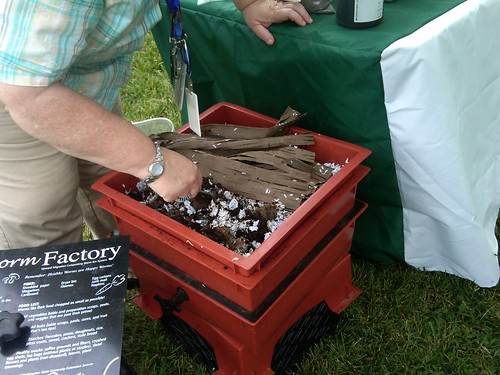Today, the People’s Garden hosted a workshop about composting. Pat Millner, who has done a lot of research on composting and utilizing compost at the USDA-Agricultural Research Service’s Beltsville Agricultural Research Center in Maryland, taught it. It was fantastically fun and informative, and Pat brought in several examples of composters for us to see.
She informed us that composting isn’t as complicated as it might seem. Composts work because microorganisms break down the material, and these microorganisms need three things to be healthy, happy and produce lots of compost: food, air, and water. If compost contains these three principles, it will be fruitful.
If you are looking to start a composter, the best season to start it is the fall. First, you need a bin. Layer about 4” of sticks (from any type of tree or shrub) in the bottom of the bin, this will provide good air flow and ventilation for the microorganisms and the compost. In your lawn, let your grass grow a little bit taller, and let the leaves fall too. Take your lawnmower and go over the area, catching the leaf/grass mix in a bag. You can put this mix in the bin, and let it take care of itself!
What about those of us who live in a condo or apartment and don’t have a lawn, or just want a smaller compost? Try a vermicomposter. A vermicomposter uses worms to break down material into compost. You can “feed” the worms in the composter veggie and fruit scraps, coffee grounds and filters, crushed eggshells, shredded office paper, and even dryer lint. However, the worms aren’t fond of citrus fruits. Meat and dairy products should always stay out of composts too, the smell may attract some unwanted critters. The worms will consume what you feed them, and there’s no need to worry about them escaping. Their castings (a fancy way to say worm poop) make for very healthy compost!
Before, when I heard about compost, the only use I knew was to enrich soil. Compost is used for much more! Runoff can create erosion and sweep away the healthy topsoil in many areas. A compost sock is a material that is filled with compost, and can be put on the side of a sloping hill, for example, to provide a filter for runoff rainwater. This can filter out any unwanted silt and even oil. Compost has also been added to places where chemicals or lead have contaminated the soil, causing plant life to die off; there, compost enriches the soil again and also blocks the harmful chemicals from being absorbed by the plants.
If you’re looking for more information on composting, take a look at The People’s Garden Healthy Workshop handout on composting. It’s a great resource.

Start a worm composter with newspaper or shredded office paper as bedding and about one pound of redworms.
